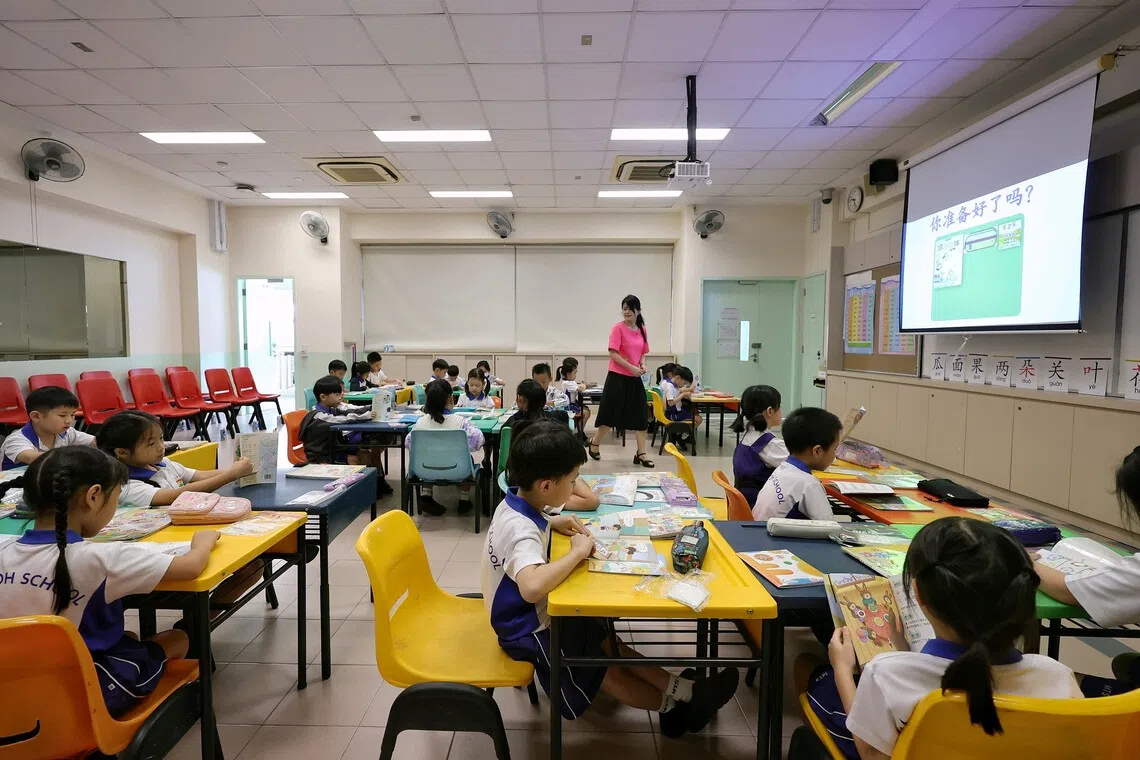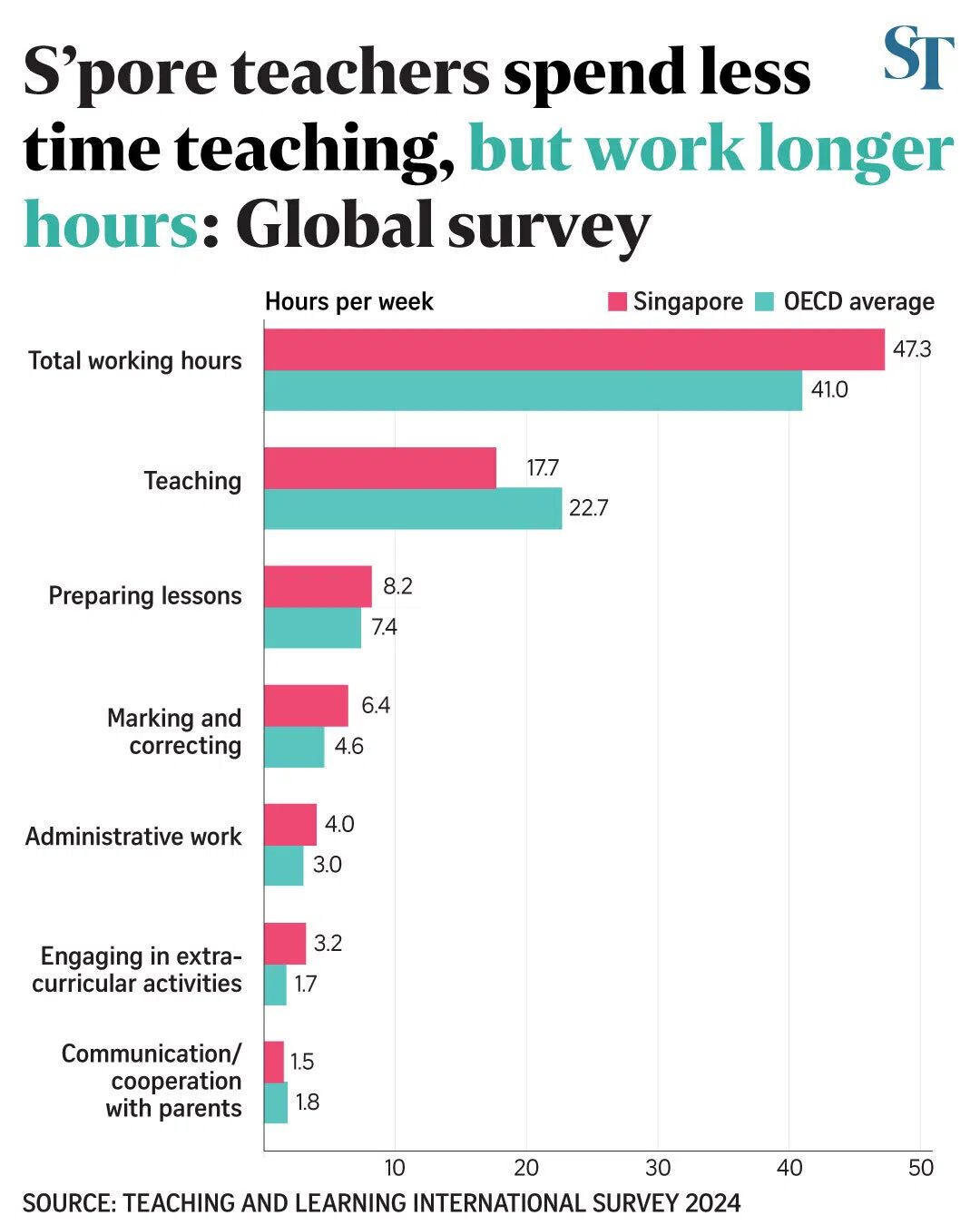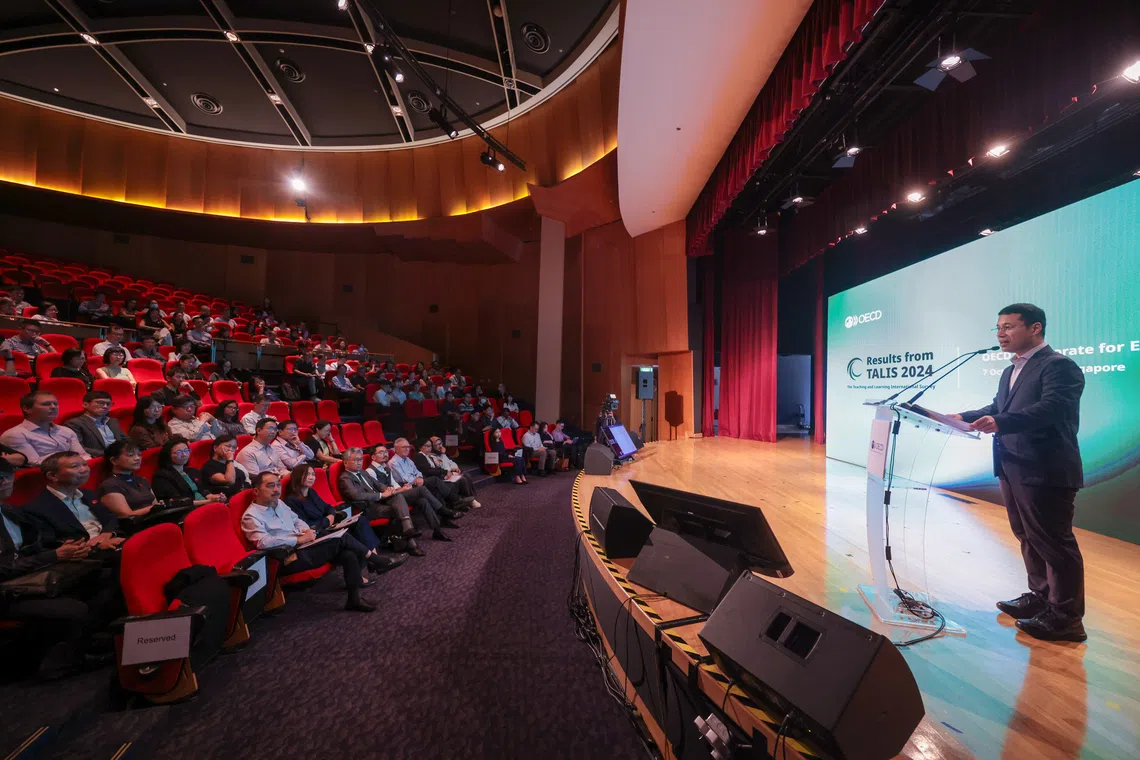Global survey finds S’pore teachers spend less time teaching and marking, but work longer hours
Sign up now: Get tips on how to help your child succeed

Teachers in Singapore reported working an average of 47.3 hours a week, higher than the OECD average of 41, according to a survey.
ST PHOTO: KEVIN LIM
Follow topic:
- Singapore teachers work 47.3 hours per week, exceeding the OECD average, with less time teaching but more on planning, counselling and parent communication.
- MOE said the balance between teaching hours and non-classroom tasks reflects the unique role of Singapore’s teachers. It added this does not mean less time on core teaching duties, but reflects a deliberate policy design to ensure educators also support students’ non-academic development.
- The survey’s findings indicate that Singapore teachers are quick to adopt digital technologies, with three in four using artificial intelligence to teach or facilitate student learning.
AI generated
SINGAPORE – Teachers in Singapore schools are spending fewer hours teaching and marking, but they are clocking more work time overall due to non-teaching tasks. These include lesson planning, student counselling, co-curricular activities and communicating with parents, a new global survey has found.
Singapore’s teachers reported working an average of 47.3 hours a week, higher than the OECD average of 41, according to the Teaching and Learning International Survey (Talis) released on Oct 7.
Teachers here are the third hardest-working in the world, up from seventh in the 2018 survey. Japan’s teachers once again come up top with 55 hours, followed by New Zealand in second, and Shanghai (China) and Alberta (Canada) tied in fourth place.
In the previous edition of the survey in 2018, teachers here said they put in 46 hours a week.
The survey’s findings also indicated that Singapore teachers are quick to adopt digital technologies
The Organisation for Economic Cooperation and Development study polled 194,000 teachers worldwide, with a total of 55 education systems joining the latest round.
The Talis survey is meant to help countries review policies to improve their teaching profession and provide information on teacher education and professional development, workload, instructional beliefs and teaching practices. Previously conducted every five years, it now takes place every six years.
This is Singapore’s third time participating. About 3,500 teachers and their principals here from all 145 secondary schools, and a random selection of 10 private schools, took the online questionnaire from April to August 2024.
The majority of Singapore teachers – more than eight in 10 – were satisfied with their jobs, noted the survey. The Ministry of Education (MOE) said that it will keep on working to ensure the teaching profession remains attractive for the long term.
More non-teaching duties
Teachers here said they spend 17.7 hours a week on actual teaching, similar to the 18 hours in 2018. The OECD average is 22.7 hours.
The time they spend on marking is 6.4 hours, down from 7.5 hours in 2018. Administrative work and preparing lessons take up four hours and 8.2 hours, respectively. In 2018, teachers spent 3.9 hours and 7.3 hours on these duties.
Teachers spent 3.2 hours each week engaging in extra-curricular activities, up from 2.8 hours in 2018. They also spent more time in 2024 counselling students, clocking 2.7 hours up from 2.5 hours previously.
The Talis report noted that Singapore teachers spent a substantial amount of time on curriculum design and training, among others. And many also engage in activities outside of their schools like workshops, conferences and field trips with students.
MOE said the total working hours recorded in 2018 and 2024 were similar.
The ministry said the balance between teaching hours and non-classroom tasks reflects the unique role of Singapore’s teachers in an education system which emphasises holistic student development.
“This should not be viewed as teachers spending less time on core teaching duties, but rather as a deliberate policy design requiring educators to also dedicate time to students’ non-academic development.
“Singapore teachers do not just teach students academic skills in the classrooms, but also engage them with a variety of activities outside of classrooms, which are important to develop them into well-rounded individuals.”

Other tasks done outside the classroom include professional learning activities, working with colleagues and counselling students.
Ms Kerry Lim, 43, Greendale Secondary School’s year head for the lower-secondary cohort, said that after the Covid-19 pandemic, teachers have noticed more students spending time alone, not interacting as much with friends and being stuck on their devices.
Hence, on top of their regular tasks, teachers have also been trying to get students to disconnect from their devices and connect more with their friends.
Workload a main source of stress
Certain workload-related factors, such as administrative duties and marking, were identified by local teachers as their main sources of stress. Being responsible for student achievement was another stress factor.
While the OECD average for teachers who experience stress “a lot” in their work is 19 per cent, in Singapore, 27 per cent of teachers reflected this sentiment – up by 4 percentage points from 2018.
Stress is inevitable in every workplace, said MOE, and it is unrealistic to eliminate all stress factors. It added that teachers’ well-being is supported in areas like whether they have autonomy in school governance and have support systems.
Speaking at the launch of the Talis 2024 report at the MOE headquarters in Buona Vista on Oct 7, Education Minister Desmond Lee said the ministry is simplifying administrative tasks through digital solutions.
For example, Parents Gateway – a digital platform for parent-school communication – allows parents to electronically submit their child’s documents for absence, such as medical certificates.
This feature will be available for all parents by the start of 2026 and aims to reduce teachers’ workload in tracking student absences.

Education Minister Desmond Lee at the launch of the Talis 2024 report on Oct 7. He said, among other things, that MOE is simplifying teachers’ administrative tasks through digital solutions.
ST PHOTO: JASON QUAH
Teachers’ well-being is also supported by setting clear communication boundaries with parents to avoid an “always-on” culture, said Mr Lee.
“We are committed to ensuring that the teaching profession remains attractive and rewarding for experienced educators who are seeking growth, as well as new graduates and mid-careerists,” he added.
At the report’s launch, American economist Eric Hanushek, who is renowned for his economic analysis of educational issues, said during a panel discussion that the skills that make teachers effective are the same ones sought across the economy, meaning schools must compete with other industries for talent.
“Singapore rewards skills of workers more than any other country in the world,” he said, adding that this means that the competition for teachers here is especially intense.
Yet Singapore has been “quite successful in that competition”, as seen by the performance of students here, said Professor Hanushek, who is Paul and Jean Hanna Senior Fellow at the Hoover Institution of Stanford University.
The Talis report noted that younger teachers under 30 were more likely to report feeling stressed “a lot” than their colleagues aged 50 and above.
MOE said that younger teachers will take time to hone their craft in areas such as lesson planning, understanding the curriculum, and navigating workplace dynamics and parent interactions. Their confidence will grow as they become more competent, it said, adding that it will continue to strengthen support for new teachers.
Also, 40 per cent of teachers under the age of 30 intended to leave the profession within the next five years – a 9 percentage point drop from 2018, but double the OECD average of 20 per cent.
Overall, 29 per cent reported planning to leave teaching. The main reasons cited were personal or family matters (71 per cent), an interest in pursuing further education (50 per cent) and shifting to a non-teaching position within education (46 per cent).
An MOE spokesman said: “Since 2018, the average annual resignation rate of teachers has remained stable at around 2 per cent to 3 per cent, which is generally lower than other schemes in the civil service.”
On the salary front, 55 per cent of Singapore teachers surveyed “agree” or “strongly agree” that they are satisfied with their salaries. This figure has fallen by 17 percentage points from 2018, although it is higher than the OECD average of 39 per cent.
Status of profession
The Talis study showed that 71 per cent of teachers in Singapore felt that teachers are valued in society, compared with the OECD average of 22 per cent. This figure remained comparable with 2018’s.
Teachers here – 57 per cent – felt that their views are valued by policymakers, higher than the OECD average of 16 per cent. This figure has increased by 7 percentage points from 2018.
Teaching was also the first career choice for more than seven in 10 teachers here.
For novice teachers – those with up to five years of teaching experience – 79 per cent felt this way.


